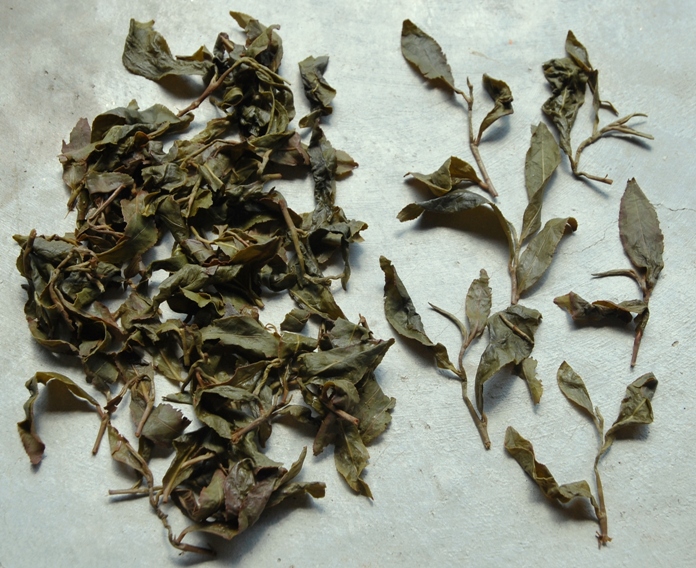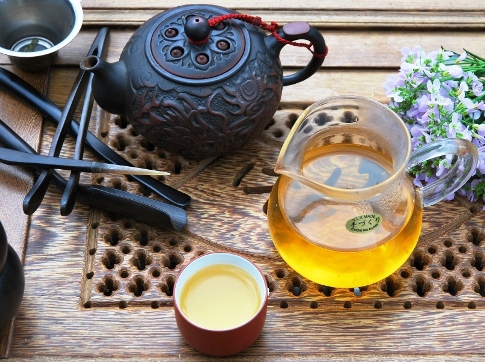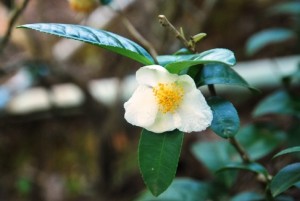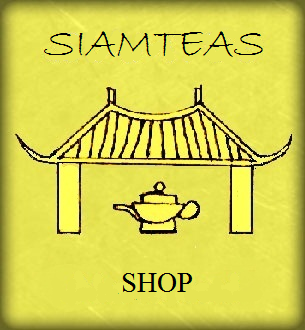Taiwan Oolong Tea Development &
Know-how Export to Thailand
 Jin Xuan Oolong No. 12 in a tea garden on Doi Tung, North Thailand
Jin Xuan Oolong No. 12 in a tea garden on Doi Tung, North Thailand
Taiwan looks back on a centuries old tradition of tea cultivation and processing and is known to tea lovers worldwide for its widely diversified portfolio at fine Oolong teas, ranging from only lightly fermented Pouchong Oolongs to the highly aromatic Ti Kuan Yin Oolong teas. While tea from two indigenous tea varietals had been enjoyed as a beverage in Taiwan already from the 17th century on, missionary monks by the end of the 18th century brought, along with the Chinese Oolong tea tradition, new tea plant varieties from the Wuji mountains in China’s Fujian province to Taiwan, where with time, and driven by both natural and human influences, they developed into a range of Taiwan Oolong teas that today are considered as characteristic for Taiwan’s tea tradition. So, besides the above mentioned teas, Oolong teas such as the Dong Ding Oolong or Oriental Beauty Oolong Tea enjoy a high reputation among tea connaisseurs.
 Doi Tung Ruan Zhi Oolong No. 17, open wet leaves
Doi Tung Ruan Zhi Oolong No. 17, open wet leaves
Recognizing the potential of the local tea industry, the Taiwanese government in the beginning of the 20th century decided to purposefully promote the development of Oolong tea varieties, and in 1926 established the Tea Research Institute of Taiwan. The institute’s work in the 1970s culminated in the setup and operation of a range of experimental stations, so-called “Taiwan Tea Experiment Stations” (TTES), where a series of Oolong tea cultivars were developed in a targeted manner on the basis of the institute’s scientific research results. Center of these efforts was the improvement of the tea plants’ characteristics in regard to taste, yield, pest resistance, as well as the adaption of each cultivar to an individual set of geological and climate conditions. The result was a range of cultivars, many of which have the number of the respective experimental station as a part of their name. While some of these cultivars seem to have passed into oblivion again, others made their way and managed to establish their names amongst the world’s finest Oolong teas.
 Taiwan cultivar Ruan Zhi Oolong No. 17 from Doi Tung, North Thailand
Taiwan cultivar Ruan Zhi Oolong No. 17 from Doi Tung, North Thailand
Now, what does all that have to to with us and our teas from North Thailand? Simply spoken, Thailand owes the rise of its tea industry and its arduously conquered entry on the world map of tea for a good part to the above described Taiwanese efforts of developing Oolong tea cultivars with defined characteristics and requirement profiles. When the Thai Royal Development Project in the 1980s identified tea as a possible cash crop to substitute the opium poppy cultivation by ethnic minorities (Chinese, different mountain tribes) in Northern Thailand, experts of the Tea Research Institute of Taiwan were brought in to determine, which of the Taiwanese cultivars would be best suitable for north Thailand’s geological and climate conditions. This way, a number of Taiwan Oolong tea cultivars finally made it to North Thailand, where they have been successfully cultivated, and where they meanwhile have developed their own northern Thai profile. Typical representatives of these cultivars in north Thailand are Jin Xuan Oolong No. 12, Ruan Zhi Oolong No. 17 and Si Ji Chun Four Seasons Oolong Tea.
 Ruan Zhi No. 17 / Jin Xuan No. 12 / 4-Seasons Si Chi Chun Oolong teas
Ruan Zhi No. 17 / Jin Xuan No. 12 / 4-Seasons Si Chi Chun Oolong teas
In regard to taste, theses typically firmly rolled teas cover quite a broad spectrum: while the Ruan Zhi Oolong No. 17 impresses with its fine honey-like sweetness, earthy taste notes are dominating in Jin Xuan Oolong No. 12, and the Four Seasons Oolong Tea, whose Chinese name ‘Si Ji Chun’ means as much as “four seasons like spring” and which supposedly can be harvested through all 4 times of a year in spring-like quality, pleases the palate with a creamy, buttery aroma and a lightly tart grassy undertone. All three cultivars are typically processed to only lightly (10 – 20%) fermented Oolong teas, with the Jin Xuan Oolong No. 12 marking the upper limit, the Ruan Zhi Oolong No. 17 being quite in the middle range, and the 4 Seasons Si Ji Chun Oolong being quite close to a green tea in terms of its oxidation level. All three cultivars are extremely pest-resistent, therby making the use of pesticides widely redundant, a basic requirement of the Thai Royal Development Project, taking strict orientation in the principles of an organic tea cultivation. Another criterion in selecting these three teas was the average altitude of North Thailand’s cultivation areas betwen 800 m and 1200 m, as well as their adaptiveness to the local climate, characterized by a hot and dry period, a hot and humid, and a cold season, when damp and cool fog lies over the mountains and tea gardens of North Thailand.
 DMS 4-Seasons Si Ji Chun Oolong tea in Gong Fu Cha style preparation
DMS 4-Seasons Si Ji Chun Oolong tea in Gong Fu Cha style preparation
While the Ruan Zhi No. 17 cultivar is also perfectly suited for being processed to green tea, the northern Thai tea industry today greatly benefits from a particularity of the Jin Xuan No. 12, namely its capacity for the processing to a Thai black tea: DMS Jin Xuan Black Pearls, a tea resembling a mild and fine Darjeeling, while standing in the tradition of Chinese “red” teas (“red” tea in China = black tea according to western definition), since its introduction in 2011 has conquered a bestseller position amongst the top northern Thai teas, and, due to its great reputation running ahead of it and the unforgettable taste experience that is inevitably connected with an degustation, has already gained cult status now.
You will find more detailed information about these as well as other Taiwan Oolong tea cultivars imported from Taiwan to north Thailand, such as our Oriental Beauty Oolong tea, on our page dedicated to the individual teas
You can buy and try these and more teas in our
where we offer you exclusively hand-picked top qualities, which we source directly on site from a few selected and controlled producers. Our relevant producer partners are smaller family operations in Doi Mae Salong and Doi Tung, to which we maintain longterm and good personal relationships, in order to be able the reserve the best for you that northern Thai tea cultivation and production have to offer.








